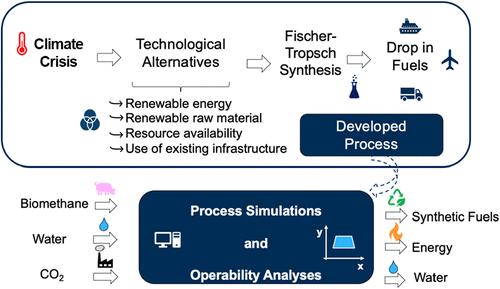Biomethane and CO2-Based Biorefinery: Process Concept and Operability Analysis
IF 3.9
3区 工程技术
Q2 ENGINEERING, CHEMICAL
引用次数: 0
Abstract
The climate crisis, along with the need to improve human living standards and preserve the environment, is driving the demand for processes that are sustainable in terms of emissions, heat demand, electricity sources, water usage, and food supply. Developing such processes requires renewable and sufficient raw materials, heat, power, and complex mass and heat integration schemes. In this context, a process for synthetic hydrocarbon production from biomethane with power cogeneration is proposed. Biomethane is used as a raw material for the process and for the power plant, while CO2 is fed to the process in similar mass proportions to biomethane. By this process, including steam methane reforming, reverse water–gas shift, and Fischer–Tropsch synthesis (FTS) reactions, it is possible to obtain 29.3 tons/h (1048 m3/day) of synthetic liquid fuels. The process is self-sufficient in terms of water and power, and it provides a considerable amount of excess heat for byproduct generation, showing itself as a promising alternative for sustainable fuel production. Operability analyses are performed for the first time in the literature on simulations of FTS plants to assess the effect of key process input variables on the simulation convergence and process output regions. A set of 26 inequality constraints that describe the feasible input region for the process is obtained, which can be used for future optimization. The proposed approach enhances the process understanding and represents an important step forward to allow hard-to-converge flowsheet optimizations of complex and highly integrated process models.

基于生物甲烷和二氧化碳的生物炼制:工艺概念和可操作性分析
气候危机,以及提高人类生活水平和保护环境的需要,正在推动对在排放、热需求、电力来源、用水和粮食供应方面具有可持续性的过程的需求。开发这样的工艺需要可再生和足够的原材料、热量、动力以及复杂的质量和热量集成方案。在此背景下,提出了一种生物甲烷热电联产合成烃的工艺。生物甲烷被用作该过程和发电厂的原料,而二氧化碳以与生物甲烷相似的质量比例被送入该过程。通过这一过程,包括蒸汽甲烷重整、逆水气转换和费托合成(FTS)反应,有可能获得29.3吨/小时(1048立方米/天)的合成液体燃料。这个过程在水和电方面是自给自足的,它为副产品的产生提供了相当多的余热,显示出它是一个有前途的可持续燃料生产替代方案。文献中首次对FTS装置的模拟进行了可操作性分析,以评估关键过程输入变量对模拟收敛和过程输出区域的影响。得到了描述该过程可行输入区域的26个不等式约束,可用于以后的优化。提出的方法增强了对过程的理解,并代表了向前迈出的重要一步,使复杂和高度集成的过程模型的难以收敛的流程图优化成为可能。
本文章由计算机程序翻译,如有差异,请以英文原文为准。
求助全文
约1分钟内获得全文
求助全文
来源期刊

Industrial & Engineering Chemistry Research
工程技术-工程:化工
CiteScore
7.40
自引率
7.10%
发文量
1467
审稿时长
2.8 months
期刊介绍:
ndustrial & Engineering Chemistry, with variations in title and format, has been published since 1909 by the American Chemical Society. Industrial & Engineering Chemistry Research is a weekly publication that reports industrial and academic research in the broad fields of applied chemistry and chemical engineering with special focus on fundamentals, processes, and products.
 求助内容:
求助内容: 应助结果提醒方式:
应助结果提醒方式:


